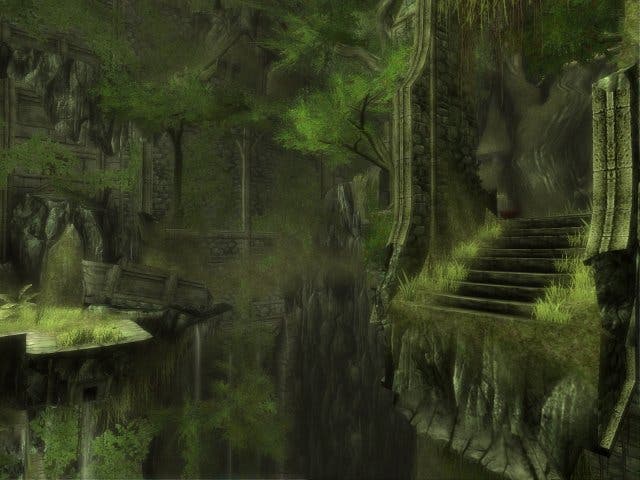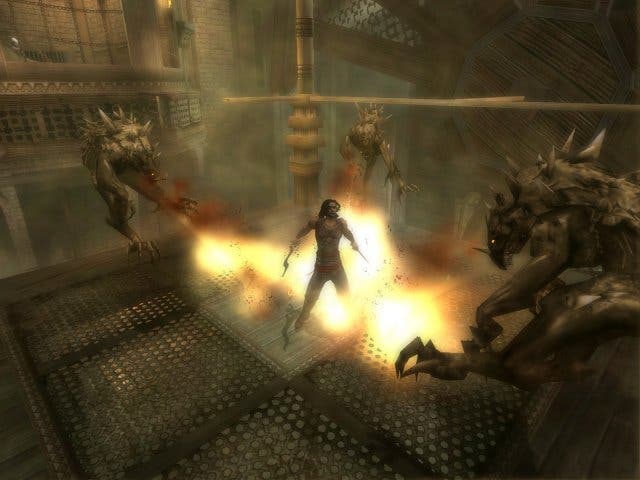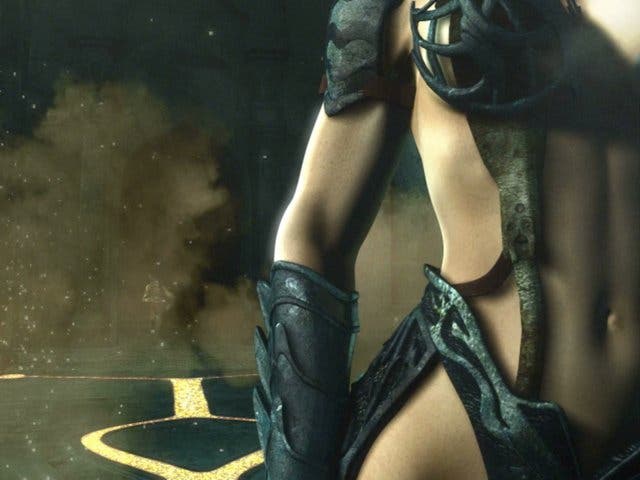Prince of Persia: Warrior Within
We need to turn back time, but we've run out of sand.
"You bitch!"
Okay, so that's a bit out of line. But in trying to summarise the Prince of Persia's dramatic shift from wash-clean poster boy for grown-up platforming into the dark shroud of whatever gothic monstrosity inspired his new look, this quote - borrowed from an early clash with a largely-naked female adversary - seems like the most obvious one to crib.
Reddy?

The Prince is a lot darker now, see. For meddling with the timeline in last year's Sands of Time, he's condemned to be stalked through life by the Dahaka, an unstoppable monster with a single objective: the Prince's death. The only way he can change his fate, the Prince reasons, is to go to the Castle of Time where the Sands were originally forged, and use some of its many portals to journey back through history and stop them ever being made in the first place, thus negating the threat of the Dahaka and virtually everything else in the process - including the first game. He will do this by running along walls, leaping balletically between ledges and horizontal bars, solving a huge number of puzzles and killing anything in his path.
Which is fair enough. Except this newfound desire to cancel out The Sands of Time seems to have spread a bit beyond the bounds of the story. You could even argue that Warrior Within does so with reckless abandon. Gone is the clever save game system, which grabbed the Prince like a squeeze-toy and gave us a quick glimpse of some of the exciting things we were about to do, meaning that we simply couldn't bring ourselves to turn off the console, and guaranteeing that the phrase "just one more go" would appear in every review. In its place you can now save whenever you find a particular water fountain. Combat is no longer held at arm's length and wheeled out between the vast puzzles, but instead crops up regularly as we try and make our way around the labyrinthine castle's many brainteasers. Twinkling corridors no longer beckon us into misty, dream-like fountain shrines that upgrade the Prince's health. And the whole game is bathed in the red glow of blood. Everything's grimmer and grimier; even the Prince himself, who seems to have arrived at the castle via a Linkin Park video - complete with a horrendous metal soundtrack that only ever feels like it belongs when the Prince climbs into a gothic elevator.
Bloody hell

It's all part of a broad effort to improve the series' appeal. Other changes include the expanded combat system that's been trailed so heavily since May. Combos are more fluid and exacting (and you can now make progress without having to rely on the back-into-the-wall-and-spring-forward-to-knock-them-over manoeuvre every single time), you can pick up a second blade which wears out over time and either use it to perform spinny and slashy combos or throw it, you can spin around pillars to slash at necks, and you no longer have to stab enemies on the floor to finish them off - although we reckon this is more in order to facilitate the gruesome decapitation/neck-slice/cut-in-half death animations than anything else.
The game is also longer, and this time it even has bosses. Proper ones. Although some of them cheekily reuse the same sort of attack combos as each other (leading to a predictable tactic of holding block, waiting for him or her to stop slashing, then jumping in for the two or three permitted strikes and retreating into a block stance again), some of them are big, challenging and inventive.
But in attempting to expand its appeal, Ubisoft has arguably robbed Prince of Persia of much of the charm that sold us The Sands of Time, and a number of basic design issues compound this problem. Combat may be better and more approachable, but it's still less than brilliant, with enemies who explode when they die (Ubisoft: go and stand in the corner) and enemies who appear out of nowhere, and while we've always held the game's controls and camera in relatively high regard compared to the rest of the genre output, we still wound up mashing buttons in frustration at the fifth pointless battle in a row and then hurling ourselves into an abyss by accidentally springing off the wall or leaping over someone's head. And even if you like the combat, we can't imagine you liking it that much after more than a handful of hours in front of the TV.
Running away made fun

And while running along walls and leaping fluidly exactly where you want to go (with the option to undo things by rewinding the game when you fail; one of the best features of the first game and a worthy survivor) is still wonderful when it's at its best, and the occasional frantic races to escape the Dahaka by racing along walls and flipping between bars at speed provide some of the game's sharpest adrenaline surges, the actual platforming process hasn't evolved much. You can slide down banners by sticking your sword in them now, and there are a couple of new breeds of spike trap, but the lack of serious changes here mean that much of the platforming - while immensely pleasurable - can be completed more or less on autopilot. Which is just as well, because there are some irritating occasions now when painful combat (usually involving prancing lady vampires or something) is tacked onto the end of a relatively straightforward but time-consuming platform section, meaning that if you end up dying repeatedly you also end up re-jumping the same gaps over and over needlessly.
The split between fighting and platforming is not as heavily slanted towards the slashing as we'd feared. All the same though, the magic balance of the first game has suffered. Few of the puzzles in Warrior Within require as much mental application as those in The Sands of Time. We used to love walking into a room and having to really think before we could get out the other side, and the satisfaction that gave us (remember the library, for example?). Here, we walk into a room and our main concerns are a) killing things, b) how long it's been since we saved, and c) whether we're in the right room at all.
The latter point is a by-product of the game's non-linearity. You spend most of your quest trying to unlock a door by taking down a pair of mechanical towers, which you can tackle in any order, and you also find yourself regularly hopping back and forward in time using portals, which shift the castle between the rundown, decrepit ruin of the present and the majestic sharpness of its heyday. But while it is visually inspiring to run through a section of crumbling castle and then come back and see it reborn, you are still fundamentally running backward and forward through the same section of crumbling castle, and the absence of the first game's comforting linearity coupled with the somewhat nondescript map ultimately renders it more dizzying than dazzling after a while, and there were definitely times when we didn't know where we were going. Or, worse, faced with a pair of routes we wound up accidentally heading off down a well-guarded and booby-trapped corridor leading to a pointless room that contained Concept Art in a treasure chest. Yeah.
Time to look good

The little irritations constantly strike hard. Like being pegged back to odd junctures when you die (having us respawn just before a tough battle with a huge enemy with only a slither of health, when we actually died climbing a section that took a further five minutes of platforming to get to, is a sure-fire way of getting us to switch off the console in disgust), or being thrown off-guard by the camera doubling back on itself, getting caught under ledges, or getting stuck in a wall.
As you get further and further into the game, you discover that you like it less and less. The platforming is still great. We feel the need to try and reinforce this at regular intervals. But so much is lost or changed to its detriment. And, frankly, the new darker approach is the key to most of the game's shortfalls. The Prince may be grittier and may snarl in battle (the majority of his enemies, for the record, screech like cats being cut in half), but this hasn't made him more accessible, it's made him less likeable. The voice acting, even in the cut-scenes (which vary from beautifully rendered to rather tedious) is hit and miss, and the script is full of lines that are so un-Prince-like that you screw up your face in embarrassment. Certainly the story can't match the plight of the Prince and Farah for emotional investment. He's just out to save his own skin. There are some busty female characters, but they merely serve to underline the game's forced maturity. The irony, of course, being that The Sands of Time was already mature - boldly different in style with an eloquent lead and a grown-up bond between two unlikely allies at the centre of it all - whereas Warrior Within feels like it's regressed into generic teenage angst with swords and impossibly-breasted harlots.
Fortunately the darkness doesn't render the graphics any less gorgeous. The sepia tint and vibrant Arabian theme may be gone, but the animation and other visual effects (particularly the use of sand and water) are still jumping much higher than most, and the environments, at their best, are extraordinarily detailed and beautiful; so much so that we can forgive the occasional dip in frame rate.
"I am the Prince of Persia." Lies. We've met him. Younger chap. Likeable.
But as you can tell we're left struggling to like it. It feels harsh to be coming down so hard on it - its platforming mechanics are still some of the best we've ever seen in a 3D game, it looks brilliant far more often than it looks poor, and it retains many of the design ideas that made the first one such a dream, even if they're not utilised quite so effectively - but The Sands of Time set such a high standard in virtually every area that anything less was always going to be disappointing, and discovering that many of the bits that were nigh on flawless are less taxing, less focused, or are just the same with a scar across the face, is deeply upsetting. As the curtain falls on Warrior Within, you can't help thinking that in trying to make the game more approachable for the masses Ubisoft has instead alienated a large number of the people who've been busy singing its praises for close to a year.
Surely the only thing more upsetting than that is the prospect of this outselling The Sands of Time, and in the process cementing a stylistic change that we, as the gamers whose enthusiasm helped justify this sequel at all, would have been far happier without. Fair's fair, Warrior Within is still better than most platformers, but we prefer things the way they used to be. Bitch.


